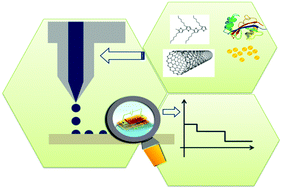_ Nanobiosensing tools section in (Nanoelectric)
Structure of Biomedicine Nanosensors and Nanobiosensors
Researcher and Author: Dr. ( Afshin Rashid)
Note: These sensors were named nanobiosensors due to their nanometer size and their application in biological environments. Nanobiosensors are very small electrodes in nanometer size and cellular dimensions that have been made sensitive to the detection of chemical or biological species of interest in cells by immobilizing specific enzymes on their surface. These sensors are used to detect and quantify species in biological systems. This technique is a very useful method in detecting the passage of some molecules through the cell wall or membrane.
In the aerospace industry, there is a need for self-locating nanochips and nanosensors that can be permanently embedded in aircraft fuselages as warning systems to indicate when an aircraft needs maintenance. In the automotive industry, nanochips and nanosensors can be used to optimize fuel consumption. In luxury cars, nanosensors can be used to improve the position of seats and controls to suit different body positions. In the next stage, it can be used in information technology to encourage the widespread use of always-on mobile computing systems.
Biosensor, and Test of care mode
A biosensor is a group of sensors designed to react with only a specific substance . The result of this reaction is a signal that a microprocessor can analyze. These sensors are used to detect and quantify species in biological systems.
These sensors consist of three parts:
A) Bioreceptor: A biological element (antibodies, nucleic acids, enzymes, cells, tissues, and other biological materials) that can selectively react only with a specific substance.
b) Detector and transducer: which comes into action after the reaction of a specific substance with biological receptors and can determine the type and amount of the reaction by various physicochemical methods (for example, by examining electrochemical, optical, mass or thermal changes before and after the reaction) and send them to the processor by means of appropriate signals.
c) Signal processors: which are mainly responsible for displaying results and performing sensor calculations.
Biosensors have attracted the attention of many research centers in recent years. Since biosensors are powerful tools for identifying biological molecules, they are now used in various medical sciences, chemical industries, food industries, environmental monitoring, and production.
They use pharmaceutical, health products, etc.
The human sense of smell and taste, which identifies different smells and tastes, or the immune system, which identifies millions of different types of molecules, are examples of natural biosensors. The most common use of biosensors is in medical diagnostics and military science. The most common use of these multifunctional sensors is in military science and in medical science, including rapid diagnosis of diseases using rapid tests or Test of care. The characteristic of these tests is the speed and cheapness of the testing method. With the introduction of nanoelectronic and microelectronic science and technology and the possibility of making electrodes on a very small scale, the manufacture of nanometer sensors has also become possible.
Conclusion:
These sensors were named nanobiosensors due to their nanometer size and their application in biological environments. Nanobiosensors are very small electrodes in nanometer size and cellular dimensions that have been made sensitive to the detection of chemical or biological species of interest in cells by immobilizing specific enzymes on their surface. These sensors are used to detect and quantify species in biological systems. This technique is a very useful method in detecting the passage of some molecules through the cell wall or membrane.
Researcher and Author: Dr. ( Afshin Rashid)
Specialized PhD in Nano-Microelectronics




